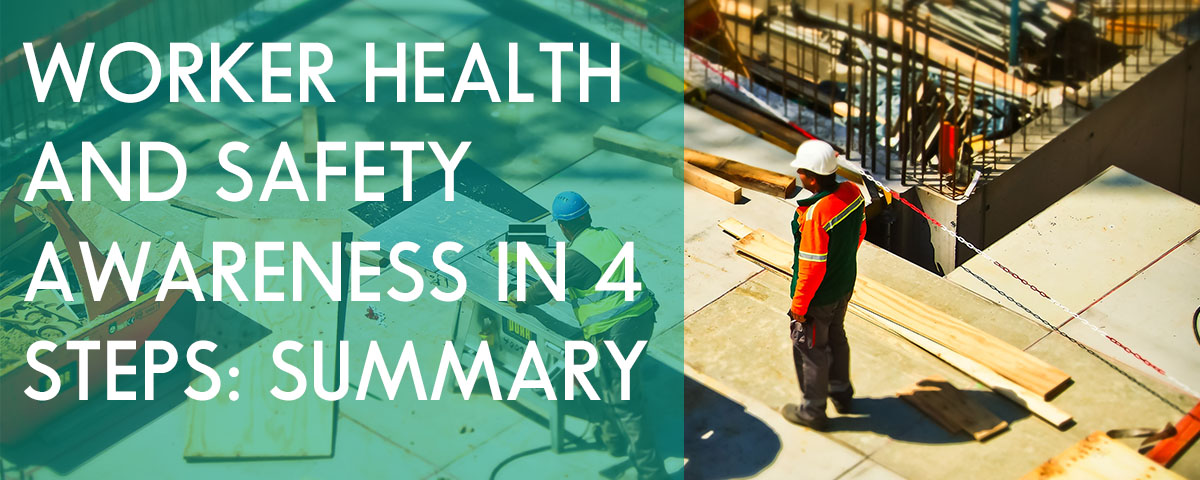Do you need workplace health and safety training? In order to gain the “Worker Health and Safety Awareness In 4 Steps” certificate, you must first complete the course. What exactly is the Worker Health and Safety Awareness In 4 Steps quiz? This page outlines information about this health and safety training quiz and Worker Health and Safety Certificate.
Feel free to jump ahead by clicking the link in the corresponding section:
- What Is The Worker Health And Safety Awareness In 4 Steps Certificate?
- Worker Health and Safety Awareness in 4 Steps Summary
- What To Expect From The Worker Health and Safety Awareness In 4 Steps
- “Worker Health And Safety In 4 Steps” Certificate
- Worker Health And Safety Awareness In 4 Steps – FAQ
For more information about worker health and safety, contact the professionals at ACUTE today!

1. What Is The Worker Health And Safety Awareness In 4 Steps Certificate?
Many workplaces require their workers to complete the Worker Health and Safety Awareness in 4 Steps training quiz. This information is posted on the Ontario Ministry of Labour, Immigration, Training and Skills Development’s website. The training tool consists of text, narration, and videos. It also includes test questions throughout the training. To see quiz tips and hints, click here!

2. Worker Health and Safety Awareness in 4 Steps Summary
The four sections of the worker health and safety awareness are getting on board, getting in the know, getting involved, and getting more help.

The main point of the getting on board section is that everyone has a role in safety. This section explains why new and young workers need to get on board, as well as explaining how the Occupational Health and Safety Act (OHSA) works.
The OHSA is a set of laws that spells out the duties of employers, supervisors, and the rights and duties of workers. The duties of each person are connected to the level of authority they have. This section of the 4-step manual walks through the duties of each level of authority, as well as the workers’ rights.

The second section of the 4-step manual describes how we need to know about the hazards. Some of the common workplace hazards are repeating the same movements over and over, slipping or tripping, working near motorized vehicles, using or working near machinery, and workplace violence. There are many ways your employers are responsible for protecting you from these hazards. It should specifically be noted that minimizing risk is always the best idea and proper protective equipment is a requirement.

Understanding the OHSA is all about knowing the health and safety duties of employers, and supervisors, and the duties and rights of workers, and putting them into action. If you see a hazard on the job, you have a duty to speak up. Employees also have the right to participate in health and safety and in keeping your workplace safe. The OHSA requires joint health and safety committees to be in place at workplaces with 6-19 workers, with at least 2 people on them.

Lastly, the worker health and safety awareness in 4 steps emphasizes the fact that you are not alone. If you see something unsafe that could hurt someone, you need to report it to your supervisor or employer. The Ministry’s job is then to help prevent workplace injuries and illnesses through enforcing the OHSA. All workers also have the right to refuse unsafe work.

3. What To Expect From The Worker Health and Safety Awareness In 4 Steps
When you open up the Worker Health and Safety Awareness in 4 Steps test page, you will be presented with an introduction. The introduction provides information about the quiz. It also provides information about how you navigate the quiz (for example, which buttons on the keyboard do what). There are four parts, or modules, to the safety training:
- “Get on Board” Module
- “Get In The Know” Module
- “Get Involved” Module
- “Get More Help” Module
This online training session and quiz help workers understand their rights and responsibilities at work. It outlines what employer’s responsibilities are and everyday tips and facts about workplace safety. The training includes interactive quizzes, reading segments, and video segments.
(Source)
We’ve also compiled an article with some sample questions and answers which you can find here. Please note this is not the real quiz and is for study purposes only.
4. “Worker Health And Safety In 4 Steps” Certificate
Once you have completed the Worker Health and Safety Awareness In 4 Steps training program, you will then be given the opportunity to fill in your name and e-mail address. Ensure you do not make any spelling mistakes! A certificate of completion will be given to you and sent to your email. Below is a link to what the certificate of completion looks like.
Certificate of completion:
https://www.labour.gov.on.ca/english/hs/elearn/worker/index.php

5. Worker Health And Safety Awareness In 4 Steps – FAQ
It is important for both employers and workers to understand the importance of safety training such as the Worker Health and Safety Awareness in 4 Steps training course. This section provides the answers to some frequently asked questions so both workers and employers can stay safe at work!
How Often Do I Need To Take This Training?
There is no expiry for this basic training program. Workers do not have to retake awareness training if they switch employers, although proof of prior completion must be provided to the new employer. Some employers may choose to provide employees with refresher training after a few years. Even though new workers with certification are not required by law to retake training, the MLITSD does state that:
“Although not required by the regulation, an employer may choose to have every new worker or supervisor complete an awareness program, even if the worker or supervisor has already completed this training with a previous employer.”
– MLITSD General Questions and Answers
Where Do I File My Certificate?
Once you have completed online training, you will be emailed a copy of your certificate. Remember that the MLITSD does NOT keep a record of your training. This means that it is up to the individual worker to provide their employer with a copy of their certificate. It is a good idea to print off two certificates and keep the original email. Provide your employer with one certificate and file your second certificate at home. A good way to keep track of certifications is to create a file specifically for work documents.
Why Is My Certificate Important?
Health and Safety Awareness training became mandatory on July 1, 2014, when Ontario Regulation 297/13 came into force. Employers are allowed to use a basic awareness training program other than the Worker Health and Safety Awareness In 4 Steps program as long as it meets the minimum content requirements set out in the regulation (source). However, the Worker Health and Safety Awareness in 4 Steps is a simple way to ensure workers and supervisors are trained by a program that meets all regulatory requirements. If employers do not have proof that workers have completed this mandatory training, there could be legal action taken.
Is The Worker Health and Safety In 4 Steps Training Enough?
Basic awareness training provides employees with a general understanding of rights, responsibilities, and how to find more information. However, many workplaces require more than basic training. The MLITSD states:
“Basic awareness training does not replace or diminish other Occupational Health and Safety Act (OHSA) training obligations.”
– MLITSD General Questions and Answers
For example, construction workers who work at heights are required to complete a CPO-approved Working At Heights training course provided by a CPO-approved training provider. Courses such as Working At Heights are industry-tailored courses, unlike the Worker Health and Safety in 4 Steps Training course. Basic awareness training is important, but it is also important for employers to know what workplace-specific training their workers may require.

Ready for quality training in your workplace?
Trust ACUTE. ACUTE helps organizations understand their training challenges while also taking care of the most crucial aspect of a safety program: providing unparalleled tailoring and customer service. Here are just a few things you can expect when training with ACUTE:
- Open Door Instructor-Student Partnership – ACUTE’s training services emphasize client participation. Staff want to build relationships with clients and serve as a touchstone for advice anytime moving forward.
- Serving Your Team and Industry – With a vast array of clients in manufacturing, construction, health, academic, and government agencies, ACUTE brings the best safety practices from across the spectrum to your workplace.
- 200 Years Combined Experience – ACUTE provides comprehensive health and safety training, on-site safety services, and consulting services. With over 100 years of combined experience, our staff offer more than theoretical or abstract ideas. ACUTE offers solutions.
- Track Record of Success – ACUTE is rated 4.9/5 stars on Google reviews, demonstrating a commitment to our clients, quality, and passion for training.

ACUTE is located in Waterloo, Ontario and services customers from cities such as Toronto, Mississauga, Brampton, Hamilton, Milton, Kitchener, London, Guelph, and other cities from across Ontario.
“We have used Acute Environmental & Safety Services Inc. for many years and our personnel always come back well trained, energized and bringing lots of ideas. They are provided with substantial and in-depth knowledge together with challenging opportunities to put into practice what they have learned into our field operations.”
– Dante, Environmental Service Company

